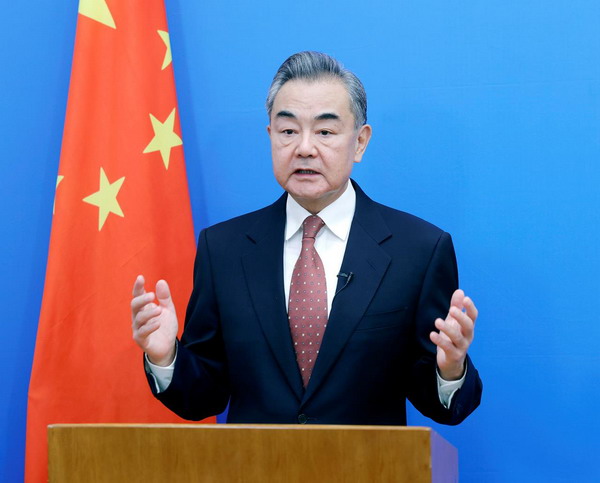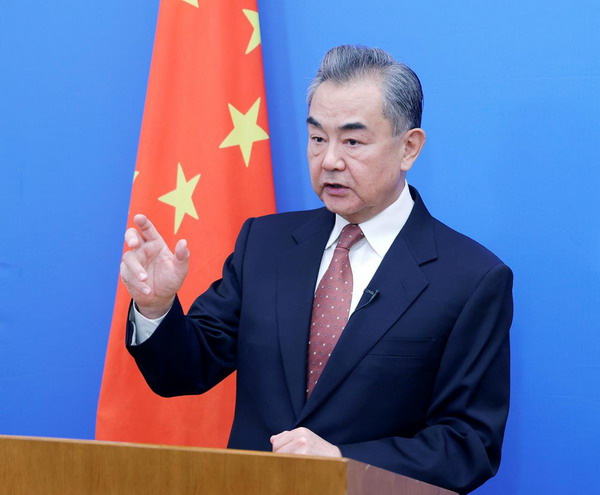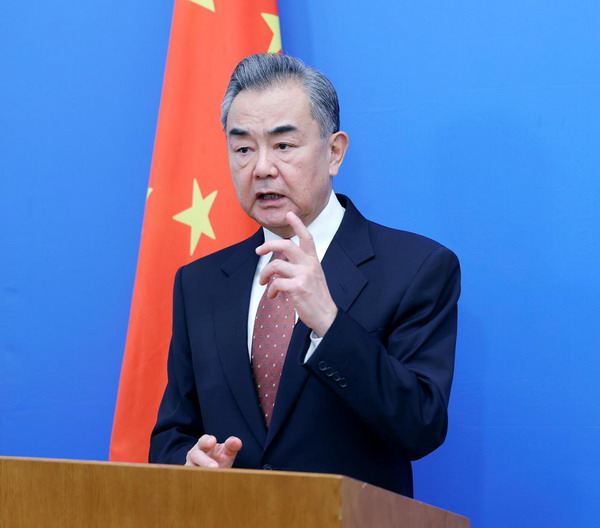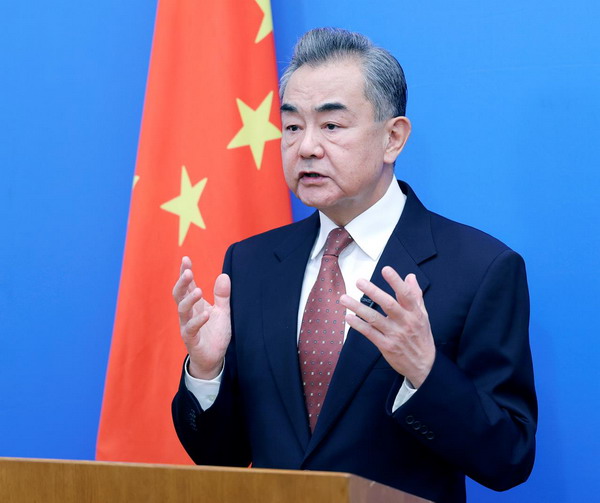Drawing Wisdom from History to Light up the Road Ahead
Drawing Wisdom from History to Light up the Road Ahead
2022-02-28 16:46

Video Address by State Councilor Wang Yi
At the Meeting in Commemoration of the 50th Anniversary of
the Shanghai Communiqué
28 February 2022
Secretary Li Qiang,
Dr. Henry Kissinger,
Friends,
Distinguished Guests,
It gives me great pleasure to attend the Meeting in Commemoration of the 50th Anniversary of the Shanghai Communiqué and, together with people from both countries, walk through again that ice-breaking journey, draw experience from history, and seek inspirations for the road ahead. Let me begin by extending congratulations on the convening of this meeting.
Fifty years ago today, right in the Jinjiang Hotel where you are gathering, China and the United States jointly issued the Shanghai Communiqué. It thus ended the prolonged estrangement between the two countries, and started the process toward normalization of China-U.S. relations. It signified the willingness of two major countries with different social systems to co-exist in peace and marked the beginning of structural transformation in international relations.
Guided by the spirit of the Shanghai Communiqué, China and the United States have achieved a series of major progress in their relations. The two countries, once at war with each other, have established 50 pairs of sister provinces/states and 233 pairs of sister cities. Before the COVID-19 pandemic, more than 300 flights shuttled between the two countries every week, and over five million travels were made across the Pacific every year. China-U.S. business ties, once negligible, expanded to U.S.$750 billion in bilateral trade and U.S.$240 billion in two-way investment. From tackling terrorism, financial crises and Ebola, to providing leadership in the signing of the JCPOA and the conclusion of the Paris Agreement on climate change, China and the United States did many great things benefiting the world through their cooperation.
As a Chinese saying goes, "When drinking water from the well, one shall not forget those who dug it." At this moment, we should pay high tribute to Chairman Mao Zedong, Premier Zhou Enlai, President Richard Nixon, Dr. Henry Kissinger, and other Chinese and U.S. leaders of the older generation. And we would also like to express our heartfelt gratitude to people from all sectors who have long committed themselves to China-U.S. friendship and cooperation.
Friends,
The China-U.S. relationship, kicked off by the Shanghai Communiqué, has gone through 50 years of development with twists and turns. To get a correct understanding of the Communiqué's spirit will help us see more clearly why the ice in the relationship thawed and barriers were removed, and know how the relationship can forge ahead.
History tells us that by following the trend of the times, we can make the right strategic choice. The issuance of the Shanghai Communiqué shook the world, and also changed the world. Chinese and U.S. leaders of the older generation discerned keenly the expectation of the world for easing international tensions, and acted on the aspiration of the Chinese and American peoples for peace and friendship between the two countries. With great political courage, they made the historic handshake across the vastest ocean in the world. Half a century later, the fundamental logic that prompted the two countries to walk toward each other remains unchanged.
History tells us that by seeking common ground while reserving differences, we can attain peaceful co-existence between countries with different social systems. The two sides "agreed to disagree" in the Shanghai Communiqué, thus making their agreement even more significant. This creative practice in the history of diplomacy provided a useful reference for the establishment and growth of relations between countries with different systems. The older generation of leaders in both countries realized that despite their differences, neither side had the intention to change the other. Both sides hoped to see that the two countries could grow in parallel and conduct cooperation based on shared interests. This is an important spirit embodied in the Shanghai Communiqué. It remains valid 50 years on today.
History tells us that by following the basic norms of international relations, we can build real guardrails for China-U.S. relations. The Taiwan question is the core issue in the Shanghai Communiqué, and the one-China principle is the cornerstone of China-U.S. relations. The Communiqué underscores that countries, regardless of their social systems, should all abide by the principles of respect for the sovereignty and territorial integrity of all states, non-aggression against other states, non-interference in the internal affairs of other states, equality and mutual benefit, and peaceful co-existence. This fully echoes the purposes and principles of the UN Charter. It worked in the past, it is relevant now, and it should be upheld in the future.

Friends,
The China-U.S. relationship is facing daunting challenges rarely seen since the establishment of the diplomatic ties. This has also caused the international community to worry deeply about the resurgence of a divided world. An important reason for this situation is that the principles and spirit established by the Shanghai Communiqué have not been truly followed.
China and the United States once again need to make a historic choice — to continue with peaceful co-existence, or to veer into conflict and confrontation; to go on with openness and cooperation, or to turn back into seclusion and antagonism? In fact, the right answer is already enshrined right there in the Shanghai Communiqué.
During his virtual meeting with President Joe Biden last November, President Xi Jinping put forward the three principles of mutual respect, peaceful co-existence and win-win cooperation, laying out the framework for future growth of China-U.S. relations. President Biden responded positively, stating that the United States does not seek a new Cold War or to change China's system, the revitalization of U.S. alliances is not anti-China, the United States does not support "Taiwan independence", and it has no intention to have a conflict with China.
These important common understandings between the two presidents are not just a furtherance of historical experience. Moreover, they are also new and creative advances that conform with the trend of the times. We urge the United States to reinstate a reasonable and pragmatic China policy, and work with China to put into real actions the common understandings between the presidents as well as President Biden's statement, in a bid to put China-U.S. relations back on track at an early date.
First, we must uphold the one-China principle and consolidate the political foundation of China-U.S. relations. Taiwan has been an inalienable part of Chinese territory since ancient times. In 1943, leaders of China, the United Kingdom and the United States issued the Cairo Declaration, stating clearly that all the territories Japan has stolen from the Chinese, such as Taiwan and the Penghu Islands, shall be restored to China. In 1945, the Potsdam Declaration, which was aimed at ending World War II, reiterated that the terms of the Cairo Declaration shall be carried out. All this shows unequivocally that there is no controversy at all in the international community regarding China's sovereignty over Taiwan. And Taiwan returned to the embrace of the motherland in accordance with law.
As a legacy of the Chinese civil war and due to the interference by the United States and other external forces, the two sides across the Taiwan Strait have been mired in a special situation of prolonged political antagonism. However, neither China's national sovereignty nor its territorial integrity has ever been divided. The fact that both the mainland and Taiwan belong to one and the same China has never changed. And the entire Chinese people have never stopped their endeavor for national reunification.
In 1971, the United States affirmed to China the new principles it would follow with regard to the Taiwan question. They include: the United States would acknowledge that there is only one China in the world and Taiwan is a part of China; the United States would not repeat the phrase that the status of Taiwan is undetermined; the United States had not supported, and would not support movements for "Taiwan independence". President Nixon reaffirmed these principles to Premier Zhou Enlai during his visit to China in 1972. That was how the Shanghai Communiqué came into being.
It is explicitly stated in the Shanghai Communiqué that the United States acknowledges that all Chinese on either side of the Taiwan Strait maintain there is but one China and that Taiwan is a part of China. The United States Government does not challenge that position. In the 1978 Joint Communiqué on the establishment of diplomatic relations, the United States acknowledges the Chinese position that there is but one China and Taiwan is a part of China; and recognizes the Government of the People's Republic of China as the sole legal Government of China. In 1982, the two sides issued the Communiqué of August 17, in which the U.S. side reiterates that it has no intention of infringing on Chinese sovereignty and territorial integrity, or interfering in China's internal affairs, or pursuing a policy of "two Chinas" or "one China, one Taiwan." The U.S. side also states that it does not seek to carry out a long-term policy of arms sales to Taiwan, and that it intends to reduce gradually its sales of arms to Taiwan, leading over a period of time to a final resolution.
However, not long after establishing diplomatic ties with China, the United States enacted the so-called "Taiwan Relations Act" and later covertly pieced together the so-called "Six Assurances" to Taiwan. Both of these were unilaterally concocted by the United States. They conflict with U.S. commitments in the three joint communiqués, and violate the one-China principle established by the UN General Assembly Resolution 2758 which is widely observed by the international community. They are therefore illegal and void from the very beginning.
China-U.S. relations, as a state-to-state relationship, can only be built on common understandings reached between both countries, namely the three joint communiqués, rather than on domestic laws or unilateral policies of the United States. That is a universally accepted international rule and a basic principle of international relations. The United States shall not place its domestic legislation above international law.
A review of this episode of history shows that facts on the Taiwan question are crystal clear, and that the historic dynamics of the one-China principle are self-evident. History brooks no falsification, and what is right or wrong should not be distorted. The United States should return to the original and true meaning of the one-China principle, honor its political commitments to China, and fulfill its due international obligations. It should stop draining the one-China principle of its essence, and hollowing it out. It should stop encouraging and supporting "Taiwan independence" moves, stop attempting to use the Taiwan question to contain China, and stop saying or doing things that interfere in China's internal affairs. Only in doing so can peace and stability across the Taiwan Strait be truly maintained and the larger interests of China-U.S. relations be upheld.

Second, we must respect each other and ensure the right direction for China-U.S. relations. China and the United States have always been, and will continue to be, countries significantly different in social system, history, culture, and many other areas. That is a fact that no one can change and also reflects the diversity of human civilization. The two sides need to view their relations in a broader perspective and more inclusive attitude, and choose dialogue over confrontation, cooperation over conflict, openness over seclusion, and integration over decoupling.
China's social system and development path are of the firm choice and collective will of the 1.4 billion Chinese people, and the natural course of the evolution of China's history. China respects the social system of the United States, and never bets against the United States. China hopes that the United States will stay open and confident, and keep growing and making progress. Likewise, the United States should respect China's development path, and welcome a peaceful, stable and prosperous China. It should abandon its mania for zero-sum games, give up its obsession with encircling and containing China, and break free from the shackles of political correctness. The United States should truly see China as a partner in the course of development, rather than an adversary in power games.
Cooperation represents the mainstream of China-U.S. relations. To define the relationship as competition is oversimplification. Even in competition, there should be boundaries, as well as widely recognized international rules based on fairness. This not only enables one country to be faster and stronger, but also makes all countries more united for a shared future. Even if there is competition, it should be about who does a better job in running the country and who contributes more to the world.
Third, we must pursue win-win cooperation and promote the development and prosperity of both countries. At present, China and the United States are both facing new circumstances for development. For China to realize high-quality development and common prosperity for all, and for the Unites States to rebuild the middle class, cooperation is the best choice for both sides. The world is big enough to accommodate the development of both China and the United States. And it expects the two countries to strive for win-win results, and achieve all-win with all other countries.
China is ready to work with the United States to fully bring out our comparative strengths, expand practical cooperation in such areas as trade, investment, energy and infrastructure, and steadily make our cooperation list longer. China will continue to comprehensively deepen reform. We will share development opportunities with the world through a shorter negative list, better business environment and greater institutional opening-up. We welcome more active involvement by U.S. firms in China's new development paradigm featuring dual circulations. The United States should also take the lead in building an open world economy and observing international economic and trade rules, and provide a fair, equitable and non-discriminatory market environment for businesses from all countries, including China.
Amity between the people holds the key to good relations between countries. People-to-people exchanges serve as a bridge for greater mutual understanding between our two peoples. We should promote the engagement, communication, exchanges and cooperation at all levels and in all areas. We should step up the exchange at sub-national levels and between cities, peoples, think tanks, media and businesses, ignite our people's enthusiasm for interactions, and strengthen the bond of friendship between China and the United States.
Fourth, we must shoulder responsibilities as major countries and provide the world with more public goods. Global challenges call for global cooperation. China and the United States, as major countries, need to stand up to the mission, and play due roles.
The two countries can join hands to provide more vaccines for Africa and the rest of the developing world, with a view to building a shield for immunity and contributing to a global victory against COVID-19. We need to maintain macroeconomic policy coordination, inject greater confidence and resilience to the global economy, and bolster solid recovery from the pandemic. We can work together to address the climate crisis, protect nature, and realize green, low-carbon and sustainable development worldwide. China is open to U.S. participation in the Belt and Road Initiative and the Global Development Initiative. We are also ready to consider coordinating with the Build Back Better World initiative of the United States to provide more quality public goods for the world.
China and the United States jointly stated in the Shanghai Communiqué that "neither should seek hegemony in the Asia-Pacific region". Today, this statement remains as relevant as ever. China has not, does not and will not seek any hegemony, and neither should the United States. The Asia-Pacific region, where the two countries' interests are most interwoven and their interactions most frequent and close, should well become a demonstration field of building mutual trust and cooperation, rather than a backyard where one pursues sphere of influence, let alone a wrestling ground for confrontation or conflict. The United States should stop initiating bloc confrontation and developing small, exclusive circles in the region. It should work with China and other regional countries to build a big Asia-Pacific family featuring openness and inclusiveness, innovation-driven growth, greater connectivity, and mutually beneficial cooperation.
Friends,
Distinguished Guests,
Both the Chinese and American peoples are great peoples. Since the door of China-U.S. relations has been opened, it should not be closed again. Since the world has emerged from the Cold War, it should not see the descending of another iron curtain. Standing at a new historical starting point, we need to draw wisdom from the Shanghai Communiqué, follow the guidance of the important common understandings between the two presidents, and find the right way for China-U.S. relations under the new circumstances on the basis of mutual respect, peaceful coexistence and win-win cooperation, so as to deliver benefits to both countries and the world. And that is the due responsibilities and obligations of China and the United States.
Thank you!


Follow us on WeChat
京ICP备18041594号-1
京公网安备 11010202005508号

Follow us on WeChat


